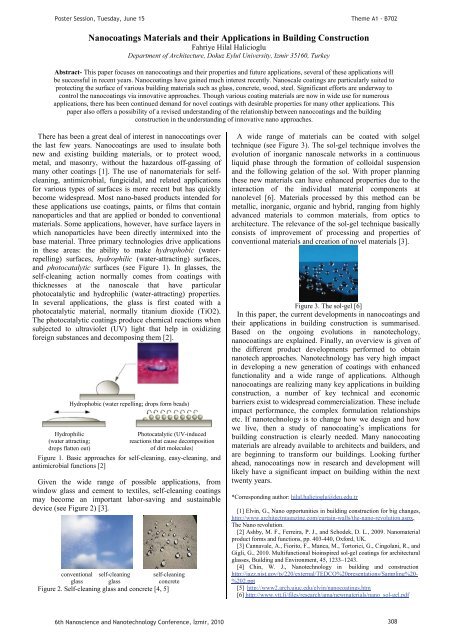Photonic crystals in biology
Photonic crystals in biology
Photonic crystals in biology
Create successful ePaper yourself
Turn your PDF publications into a flip-book with our unique Google optimized e-Paper software.
Poster Session, Tuesday, June 15<br />
Theme A1 - B702<br />
Nanocoat<strong>in</strong>gs Materials and their Applications <strong>in</strong> Build<strong>in</strong>g Construction<br />
Fahriye Hilal Halicioglu<br />
Department of Architecture, Dokuz Eylul University, Izmir 35160, Turkey<br />
Abstract- This paper focuses on nanocoat<strong>in</strong>gs and their properties and future applications, several of these applications will<br />
be successful <strong>in</strong> recent years. Nanocoat<strong>in</strong>gs have ga<strong>in</strong>ed much <strong>in</strong>terest recently. Nanoscale coat<strong>in</strong>gs are particularly suited to<br />
protect<strong>in</strong>g the surface of various build<strong>in</strong>g materials such as glass, concrete, wood, steel. Significant efforts are underway to<br />
control the nanocoat<strong>in</strong>gs via <strong>in</strong>novative approaches. Though various coat<strong>in</strong>g materials are now <strong>in</strong> wide use for numerous<br />
applications, there has been cont<strong>in</strong>ued demand for novel coat<strong>in</strong>gs with desirable properties for many other applications. This<br />
paper also offers a possibility of a revised understand<strong>in</strong>g of the relationship between nanocoat<strong>in</strong>gs and the build<strong>in</strong>g<br />
construction <strong>in</strong> the understand<strong>in</strong>g of <strong>in</strong>novative nano approaches.<br />
There has been a great deal of <strong>in</strong>terest <strong>in</strong> nanocoat<strong>in</strong>gs over<br />
the last few years. Nanocoat<strong>in</strong>gs are used to <strong>in</strong>sulate both<br />
new and exist<strong>in</strong>g build<strong>in</strong>g materials, or to protect wood,<br />
metal, and masonry, without the hazardous off-gass<strong>in</strong>g of<br />
many other coat<strong>in</strong>gs [1]. The use of nanomaterials for selfclean<strong>in</strong>g,<br />
antimicrobial, fungicidal, and related applications<br />
for various types of surfaces is more recent but has quickly<br />
become widespread. Most nano-based products <strong>in</strong>tended for<br />
these applications use coat<strong>in</strong>gs, pa<strong>in</strong>ts, or films that conta<strong>in</strong><br />
nanoparticles and that are applied or bonded to conventional<br />
materials. Some applications, however, have surface layers <strong>in</strong><br />
which nanoparticles have been directly <strong>in</strong>termixed <strong>in</strong>to the<br />
base material. Three primary technologies drive applications<br />
<strong>in</strong> these areas: the ability to make hydrophobic (waterrepell<strong>in</strong>g)<br />
surfaces, hydrophilic (water-attract<strong>in</strong>g) surfaces,<br />
and photocatalytic surfaces (see Figure 1). In glasses, the<br />
self-clean<strong>in</strong>g action normally comes from coat<strong>in</strong>gs with<br />
thicknesses at the nanoscale that have particular<br />
photocatalytic and hydrophilic (water-attract<strong>in</strong>g) properties.<br />
In several applications, the glass is first coated with a<br />
photocatalytic material, normally titanium dioxide (TiO2).<br />
The photocatalytic coat<strong>in</strong>gs produce chemical reactions when<br />
subjected to ultraviolet (UV) light that help <strong>in</strong> oxidiz<strong>in</strong>g<br />
foreign substances and decompos<strong>in</strong>g them [2].<br />
Hydrophobic (water repell<strong>in</strong>g; drops form beads)<br />
Hydrophilic<br />
(water attract<strong>in</strong>g;<br />
drops flatten out)<br />
Photocatalytic (UV-<strong>in</strong>duced<br />
reactions that cause decomposition<br />
of dirt molecules)<br />
Figure 1. Basic approaches for self-clean<strong>in</strong>g, easy-clean<strong>in</strong>g, and<br />
antimicrobial functions [2]<br />
Given the wide range of possible applications, from<br />
w<strong>in</strong>dow glass and cement to textiles, self-clean<strong>in</strong>g coat<strong>in</strong>gs<br />
may become an important labor-sav<strong>in</strong>g and susta<strong>in</strong>able<br />
device (see Figure 2) [3].<br />
conventional self-clean<strong>in</strong>g self-clean<strong>in</strong>g<br />
glass glass<br />
concrete<br />
Figure 2. Self-clean<strong>in</strong>g glass and concrete [4, 5]<br />
A wide range of materials can be coated with solgel<br />
technique (see Figure 3). The sol-gel technique <strong>in</strong>volves the<br />
evolution of <strong>in</strong>organic nanoscale networks <strong>in</strong> a cont<strong>in</strong>uous<br />
liquid phase through the formation of colloidal suspension<br />
and the follow<strong>in</strong>g gelation of the sol. With proper plann<strong>in</strong>g<br />
these new materials can have enhanced properties due to the<br />
<strong>in</strong>teraction of the <strong>in</strong>dividual material components at<br />
nanolevel [6]. Materials processed by this method can be<br />
metallic, <strong>in</strong>organic, organic and hybrid, rang<strong>in</strong>g from highly<br />
advanced materials to common materials, from optics to<br />
architecture. The relevance of the sol-gel technique basically<br />
consists of improvement of process<strong>in</strong>g and properties of<br />
conventional materials and creation of novel materials [3].<br />
Figure 3. The sol-gel [6]<br />
In this paper, the current developments <strong>in</strong> nanocoat<strong>in</strong>gs and<br />
their applications <strong>in</strong> build<strong>in</strong>g construction is summarised.<br />
Based on the ongo<strong>in</strong>g evolutions <strong>in</strong> nanotechology,<br />
nanocoat<strong>in</strong>gs are expla<strong>in</strong>ed. F<strong>in</strong>ally, an overview is given of<br />
the different product developments performed to obta<strong>in</strong><br />
nanotech approaches. Nanotechnology has very high impact<br />
<strong>in</strong> develop<strong>in</strong>g a new generation of coat<strong>in</strong>gs with enhanced<br />
functionality and a wide range of applications. Although<br />
nanocoat<strong>in</strong>gs are realiz<strong>in</strong>g many key applications <strong>in</strong> build<strong>in</strong>g<br />
construction, a number of key technical and economic<br />
barriers exist to widespread commercialization. These <strong>in</strong>clude<br />
impact performance, the complex formulation relationships<br />
etc. If nanotechnology is to change how we design and how<br />
we live, then a study of nanocoat<strong>in</strong>gs implications for<br />
build<strong>in</strong>g construction is clearly needed. Many nanocoat<strong>in</strong>g<br />
materials are already available to architects and builders, and<br />
are beg<strong>in</strong>n<strong>in</strong>g to transform our build<strong>in</strong>gs. Look<strong>in</strong>g further<br />
ahead, nanocoat<strong>in</strong>gs now <strong>in</strong> research and development will<br />
likely have a significant impact on build<strong>in</strong>g with<strong>in</strong> the next<br />
twenty years.<br />
*Correspond<strong>in</strong>g author: hilal.halicioglu@deu.edu.tr<br />
[1] Elv<strong>in</strong>, G., Nano opportunities <strong>in</strong> build<strong>in</strong>g construction for big changes,<br />
http://www.architectmagaz<strong>in</strong>e.com/curta<strong>in</strong>-walls/the-nano-revolution.aspx,<br />
The Nano revolution.<br />
[2] Ashby, M. F., Ferreira, P. J., and Schodek, D. L., 2009. Nanomaterial<br />
product forms and functions, pp. 403-440, Oxford, UK.<br />
[3] Cannavale, A., Fiorito, F., Manca, M., Tortorici, G., C<strong>in</strong>golani, R., and<br />
Gigli, G., 2010. Multifunctional bio<strong>in</strong>spired sol-gel coat<strong>in</strong>gs for architectural<br />
glasses, Build<strong>in</strong>g and Environment, 45, 12331243.<br />
[4] Ch<strong>in</strong>, W. J., Nanotechnology <strong>in</strong> build<strong>in</strong>g and construction<br />
http://jazz.nist.gov/ts/220/external/TEDCO%20presentations/Sampl<strong>in</strong>g%20-<br />
%202.ppt<br />
[5] http://www2.arch.uiuc.edu/elv<strong>in</strong>/nanocoat<strong>in</strong>gs.htm<br />
[6] http://www.vtt.fi/files/research/ama/newmaterials/nano_sol-gel.pdf<br />
6th Nanoscience and Nanotechnology Conference, zmir, 2010 308













